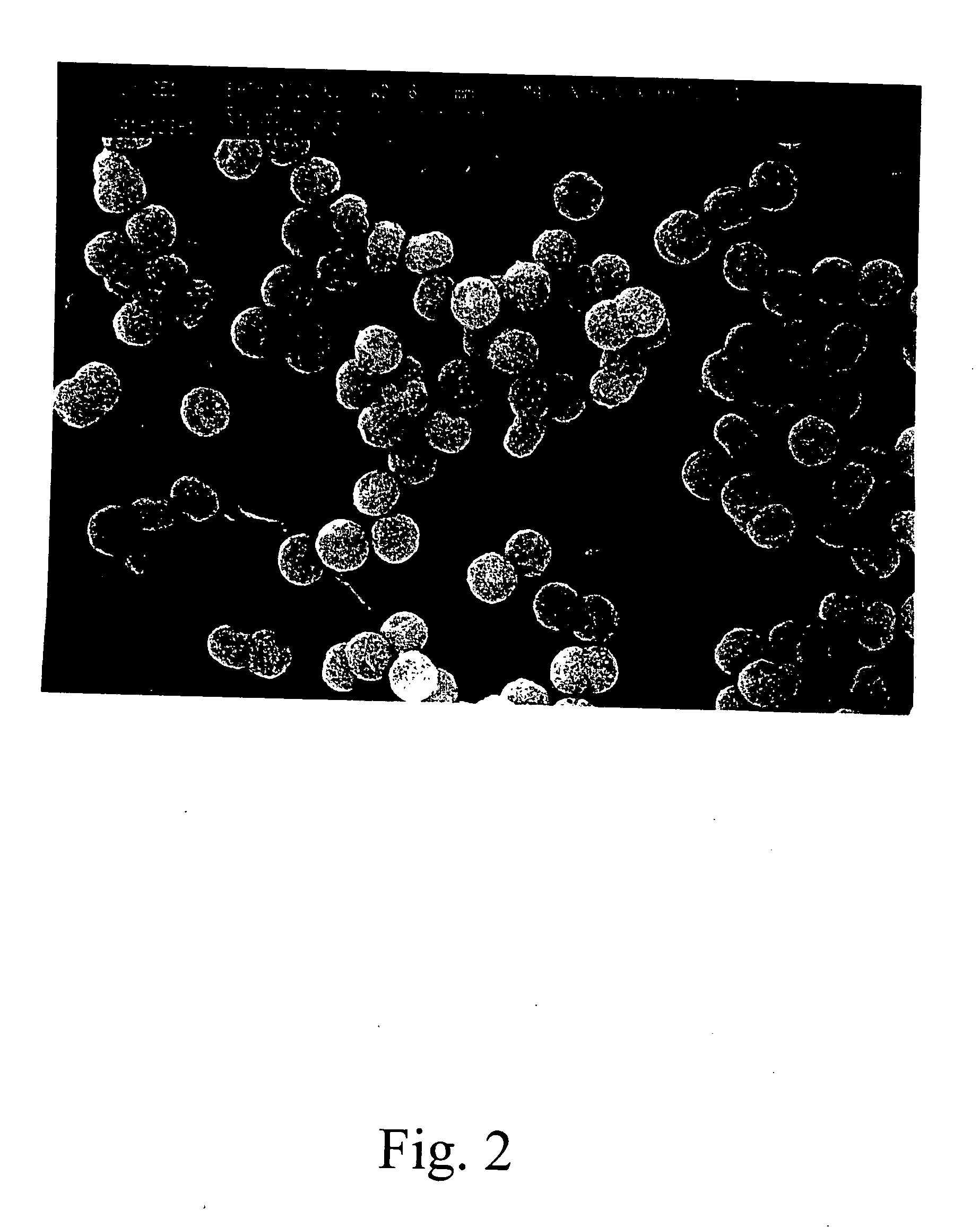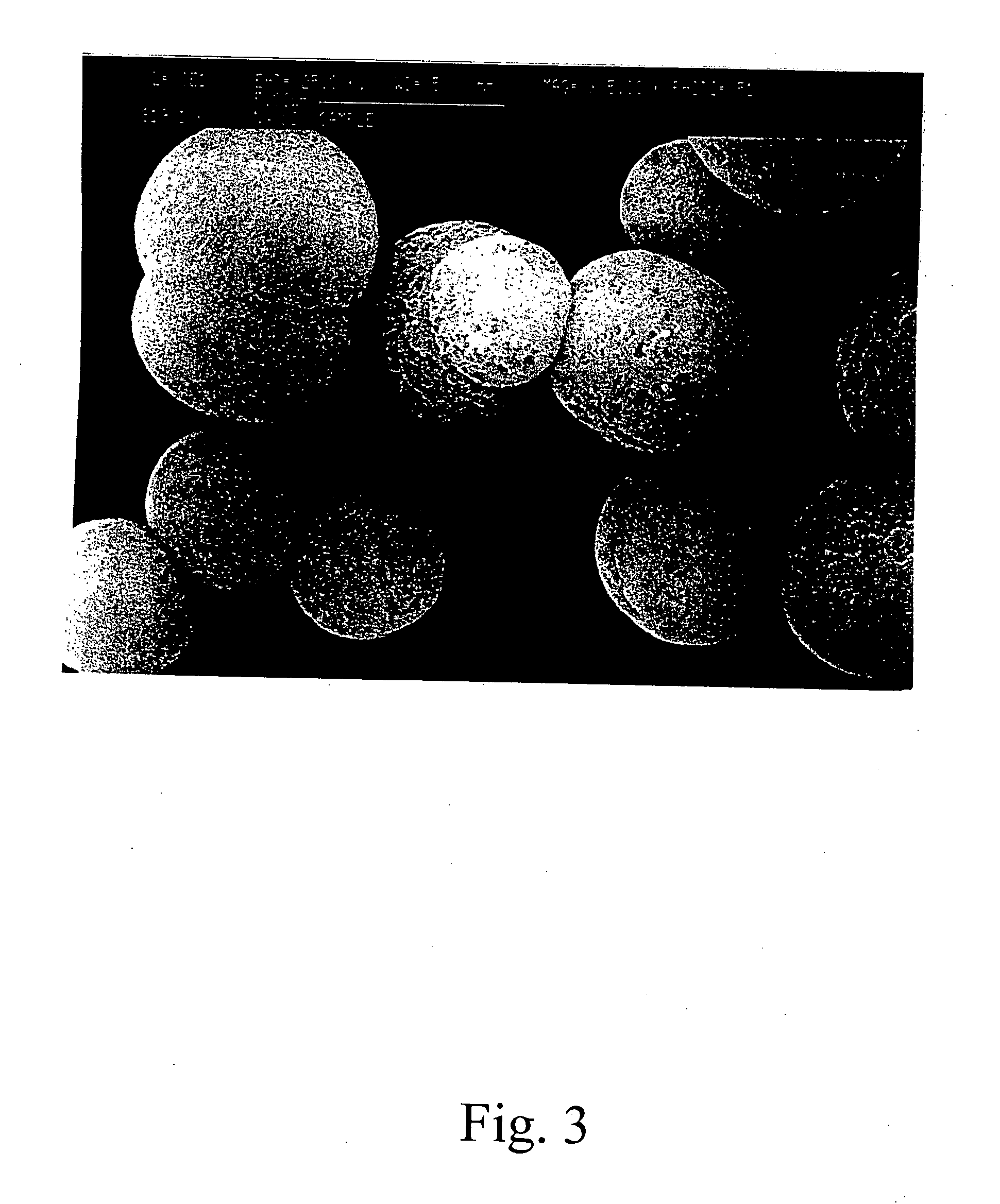Stabilized vaterite
a technology of stabilizing vaterite and vaterite, which is applied in the direction of magnetene compounds, dentistry, chemistry apparatus and processes, etc., can solve the problems of carbonates having either poor cleaning ability, losing their spherical shape, and undesirable to most dentifrice formulators
- Summary
- Abstract
- Description
- Claims
- Application Information
AI Technical Summary
Problems solved by technology
Method used
Image
Examples
example 1
[0040] A stable spherical vaterite calcium carbonate material was prepared in accordance with the present invention as follows. First, 4 liters of 2 M reagent grade sodium carbonate was added to a rotor-stator, high speed dispersion Kady® lab mill (model number L) available from Kady International, Scarborough, Me. Next, 4 liters of 2 M reagent grade calcium chloride was poured into the sodium carbonate solution. The mixture was stirred with the Kady mill at 40 Hz for five minutes. The reaction was carried out at room temperature (25° C.). To the resultant vaterite slurry was added 1.4 g of sodium polyphosphate, (NaPO3)n available from Aldrich Chemical Company. The slurry was placed in a 5-gal. plastic bucket. Three more batches of vaterite were prepared as described above and the slurries were all combined in the bucket. Thereafter, the combined slurry was filtered on a buchner funnel and washed with deionized water. The filter cake was dried in an oven at 100° C. overnight. Physic...
example 2
[0041] A stable vaterite calcium carbonate was prepared by first preparing a solution of 2 molar calcium chloride and 4 molar monoethanolamine. This solution was stored for 2 weeks before use. 6 liters of the previously prepared calcium chloride / monoethanolamine solution was added to a 5-gal reactor equipped with mechanical stirring means. The pH of this solution was 11.1. Carbon dioxide gas was added to the stirred reactor contents at a rate of 22.5 L / min. Carbonation continued until the reaction mixture reached pH 7.46, which took about 34 minutes. Carbonation and stirring was stopped for 30 minutes. Thereafter, carbonation and stirring resumed until the reaction slurry reached pH 6.87. The resultant vaterite slurry was filtered and washed with deionized water until the filtrate slurry reached a conductivity of 500 μS, indicating the by-product salt had been washed from the wet cake. The vaterite wet cake was stabilized by mixing 12 g of sodium polyphosphate into the wet cake. The...
example 4
[0048] The procedure of Example 2 was followed, except various amounts of stabilizing chemicals were added to the vaterite wet cake, which was then dried overnight in an oven at 100° C. The dried, stabilized vaterite was then put into water and aged for specified times at 120° F. to simulate stability in toothpaste formulations. Stability of the vaterite was judged by viewing the particle morphology with an optical microscope.
[0049] The stabilizing chemicals used were reagent grade sodium polyphosphate, (NaPo3)n, and reagent grade sodium polysulfonate available from Aldrich Chemicals; tetrasodium salt of 1-hydroxyethane-1,1-diphosphonic acid (HEDP), 21% active, also known as tetrasodium etidronate, available as Briquest ADPA 21 SH; and amino-tri (methylenephosphonate) sodium salt, (ATMP), 30% active, available as Briquest 301-30SH, both available from Albright & Wilson Americas, Glen Allen, Va. The results of this accelerated aging test are given below in Table 2.
TABLE 2Accelerat...
PUM
| Property | Measurement | Unit |
|---|---|---|
| particle size | aaaaa | aaaaa |
| particle size | aaaaa | aaaaa |
| particle size | aaaaa | aaaaa |
Abstract
Description
Claims
Application Information
 Login to View More
Login to View More - R&D
- Intellectual Property
- Life Sciences
- Materials
- Tech Scout
- Unparalleled Data Quality
- Higher Quality Content
- 60% Fewer Hallucinations
Browse by: Latest US Patents, China's latest patents, Technical Efficacy Thesaurus, Application Domain, Technology Topic, Popular Technical Reports.
© 2025 PatSnap. All rights reserved.Legal|Privacy policy|Modern Slavery Act Transparency Statement|Sitemap|About US| Contact US: help@patsnap.com



